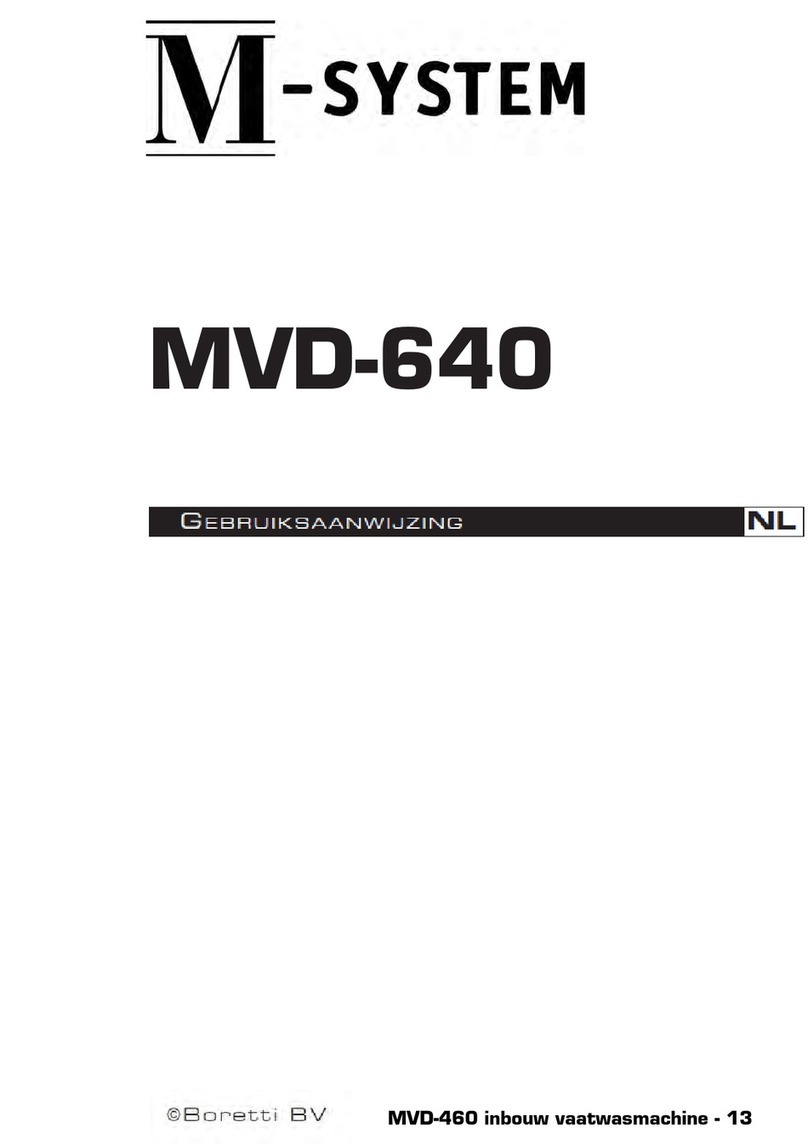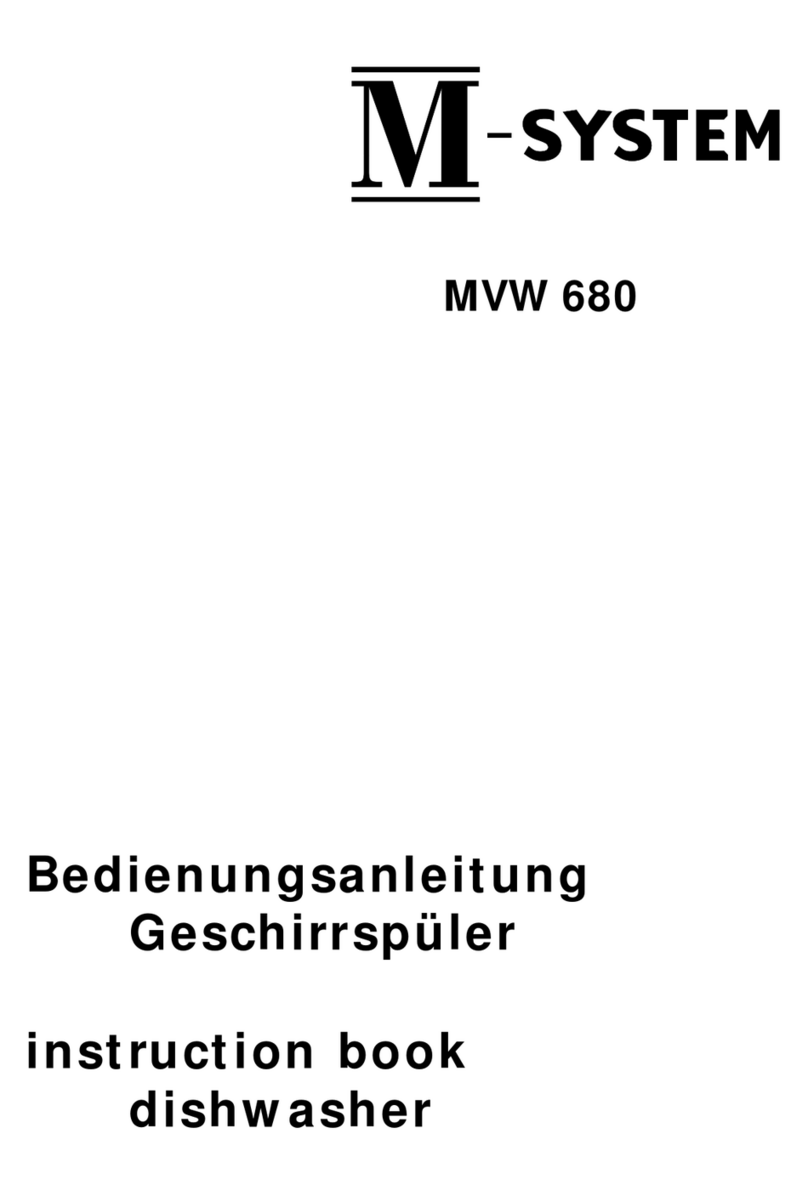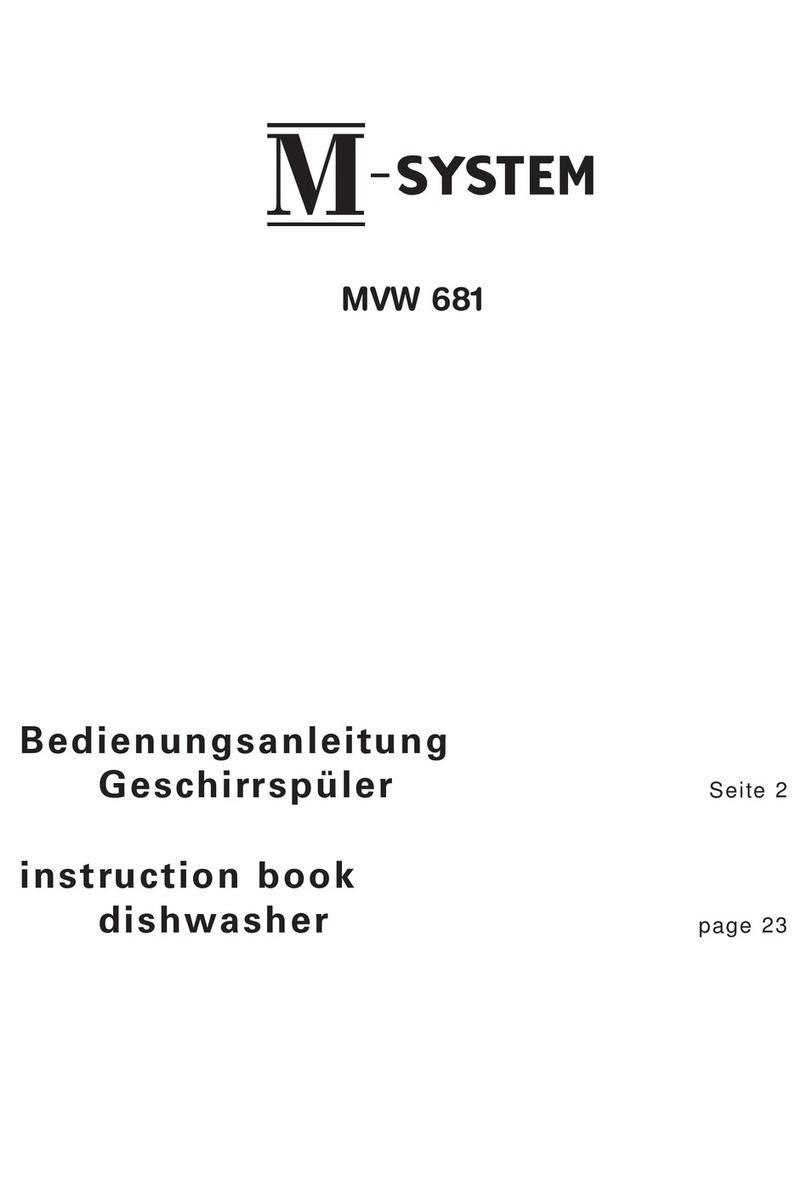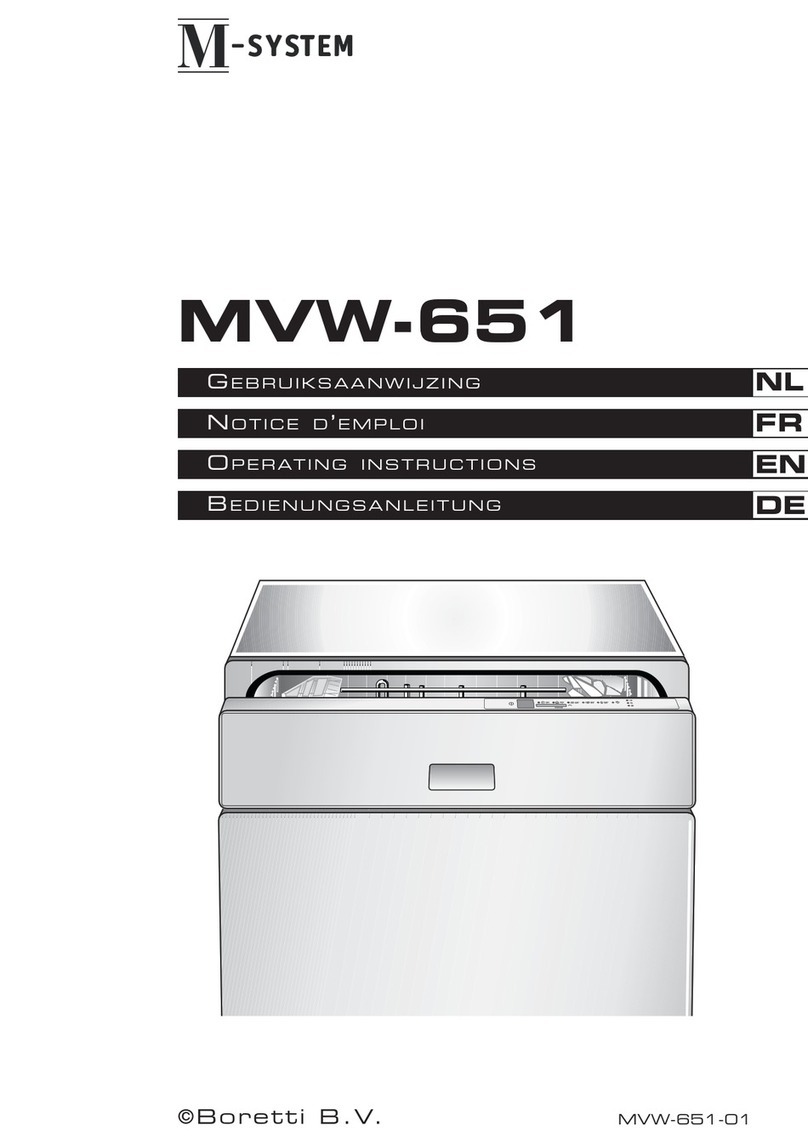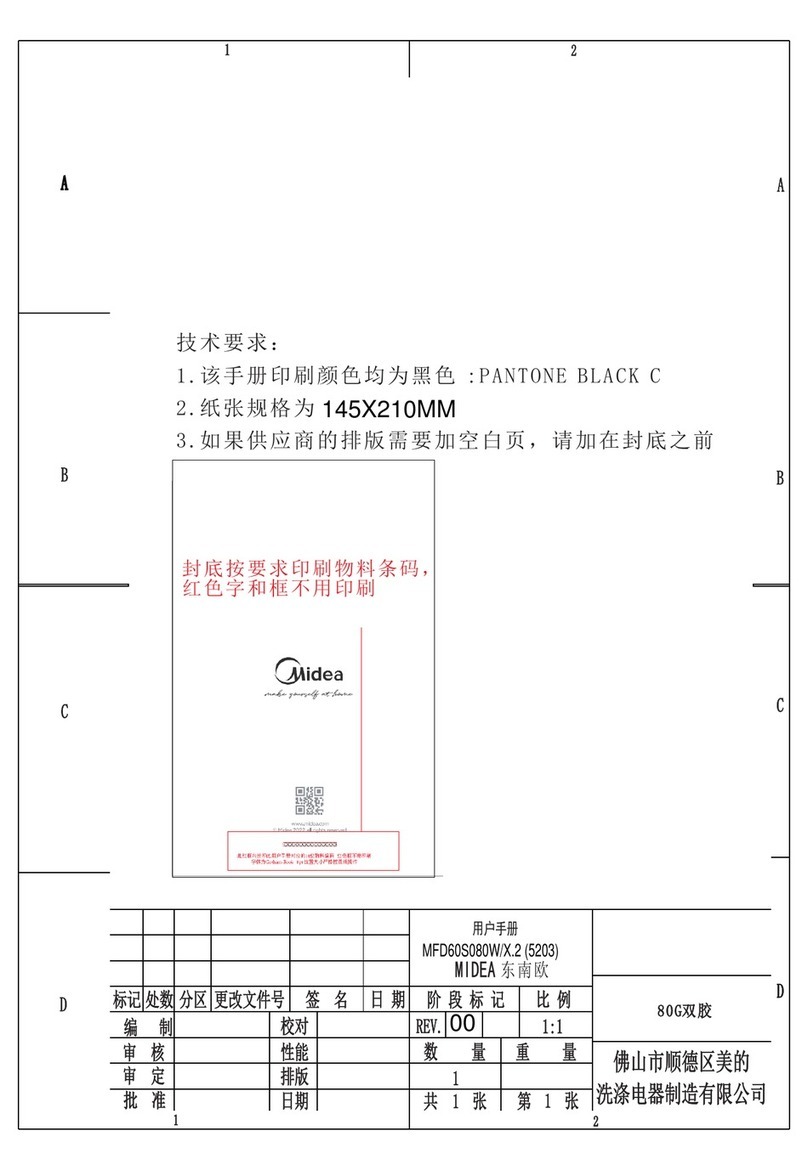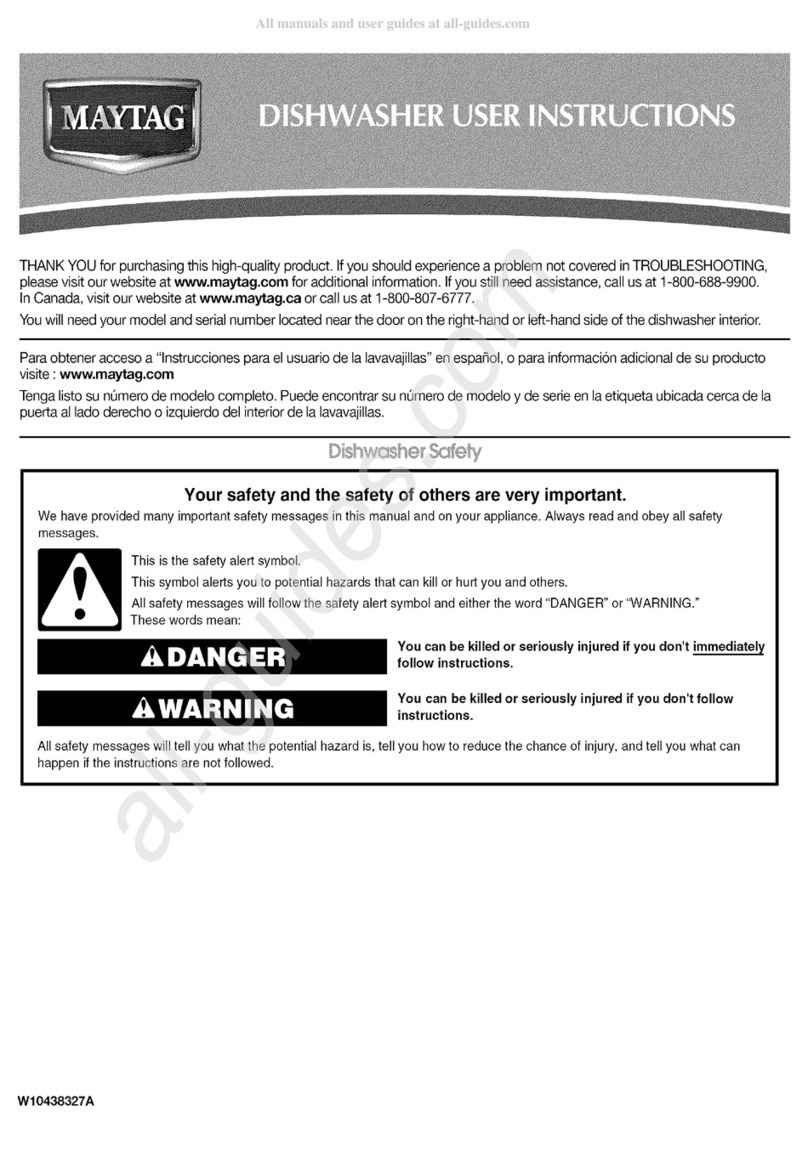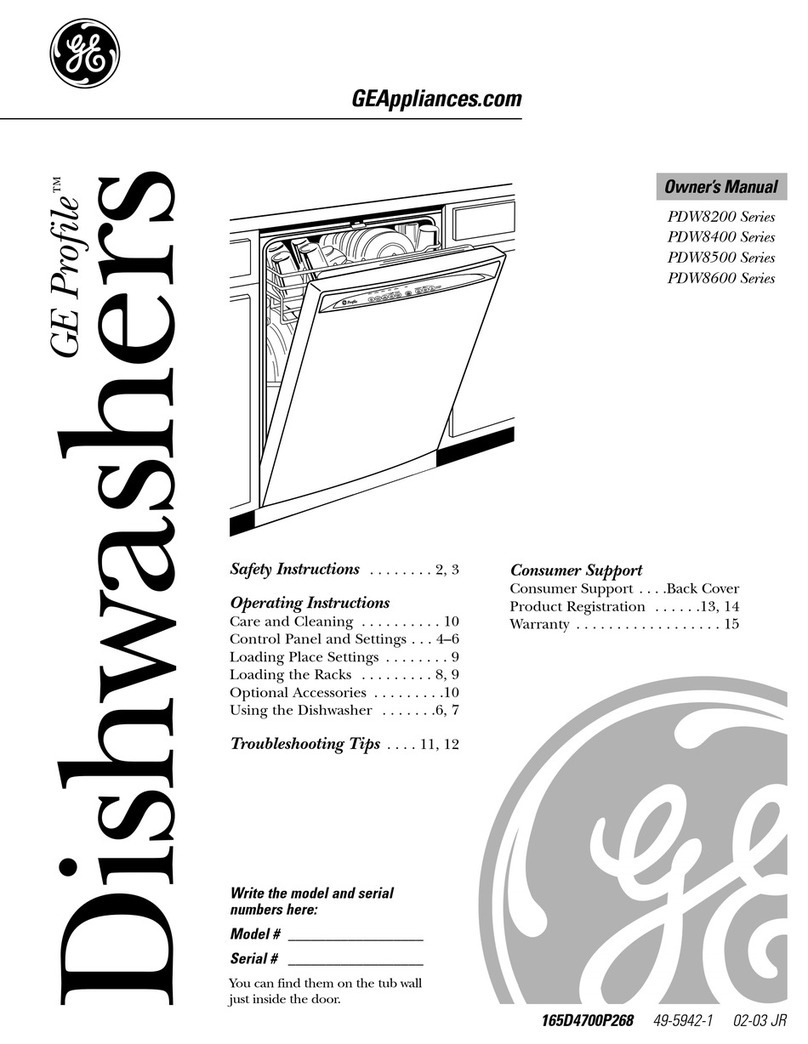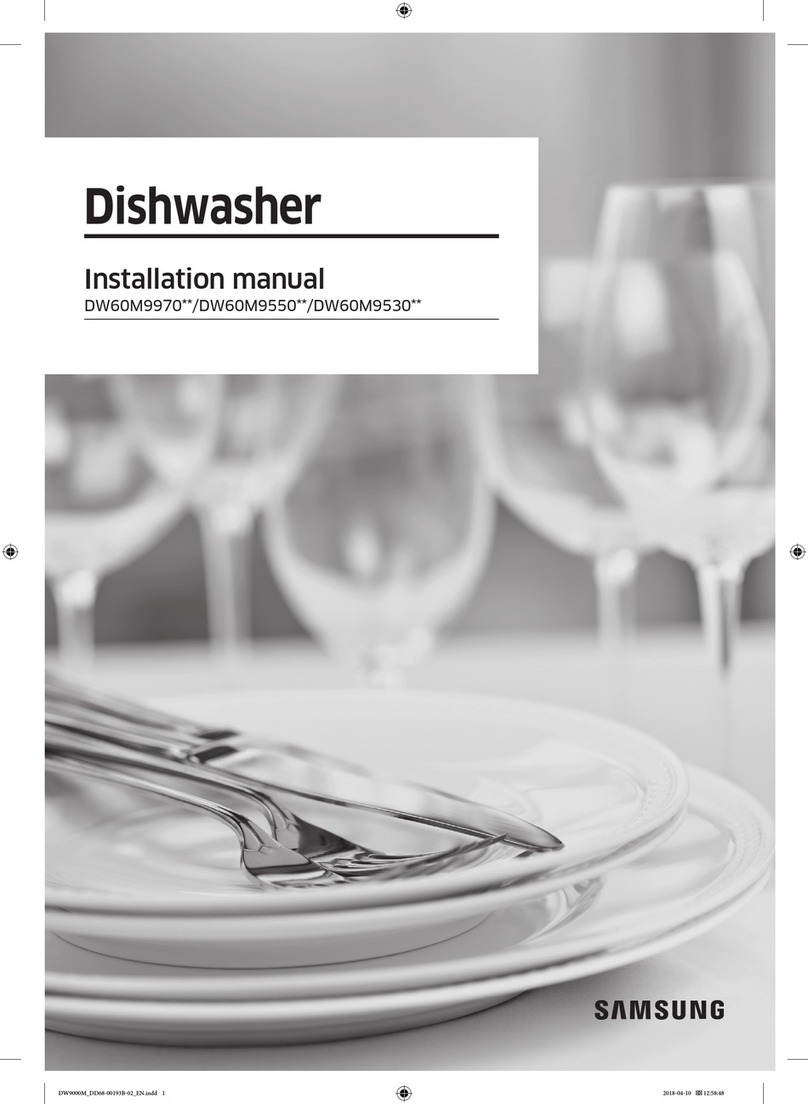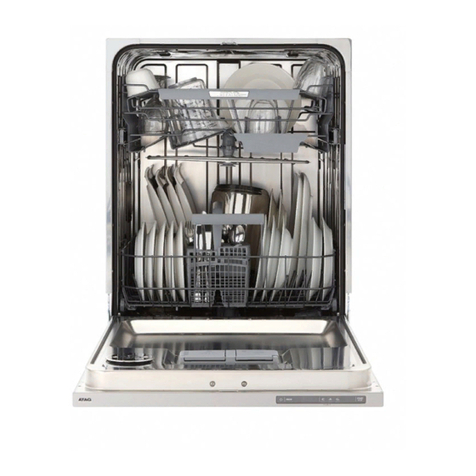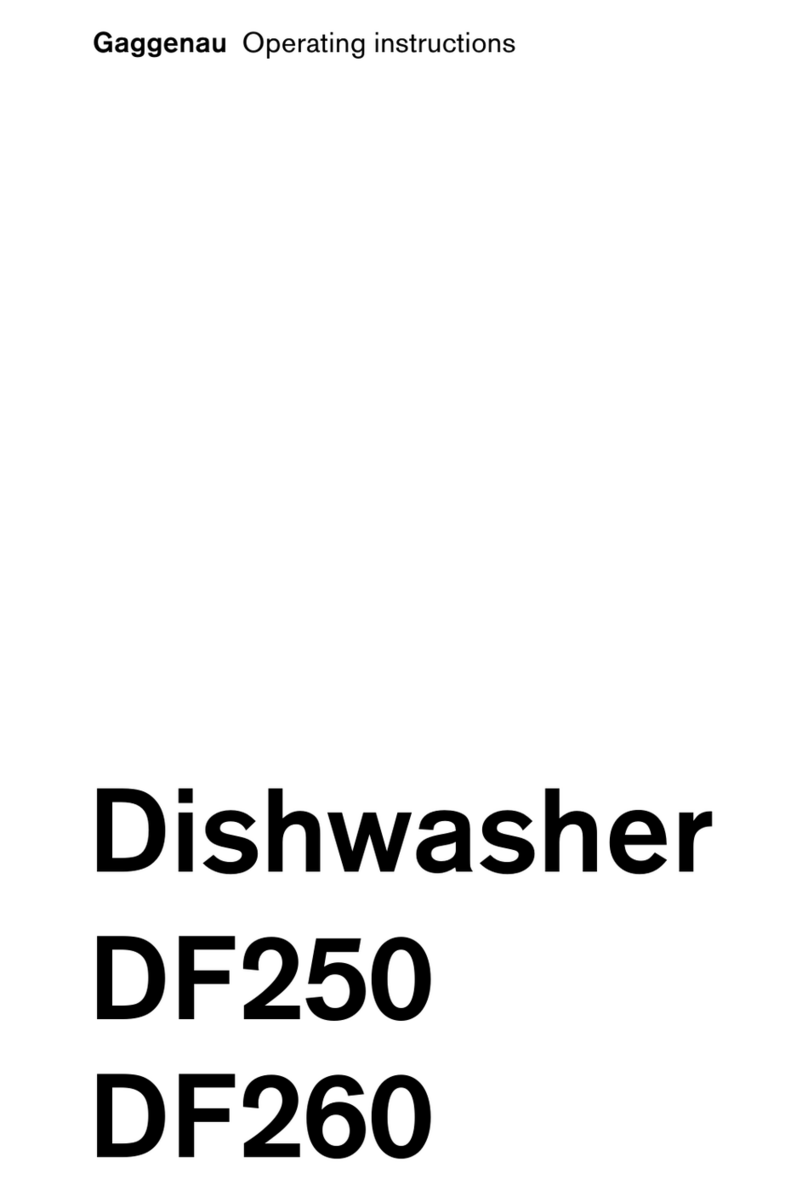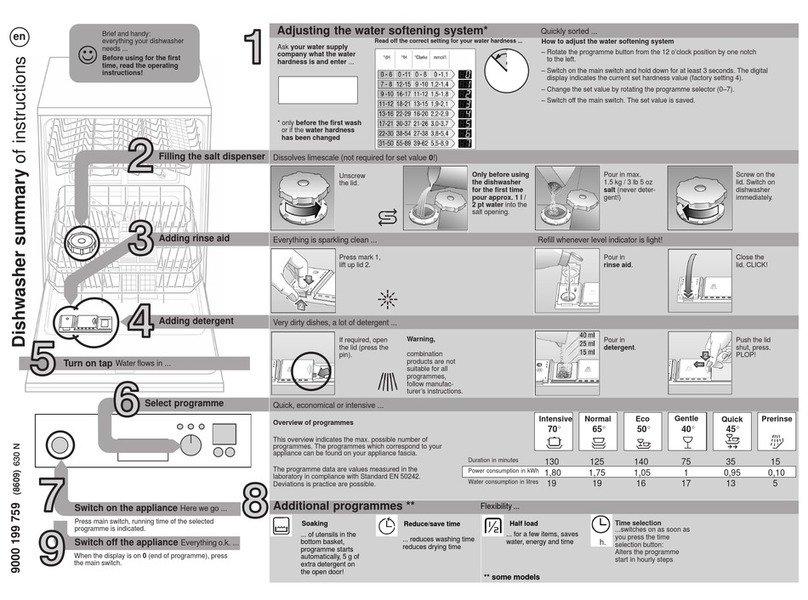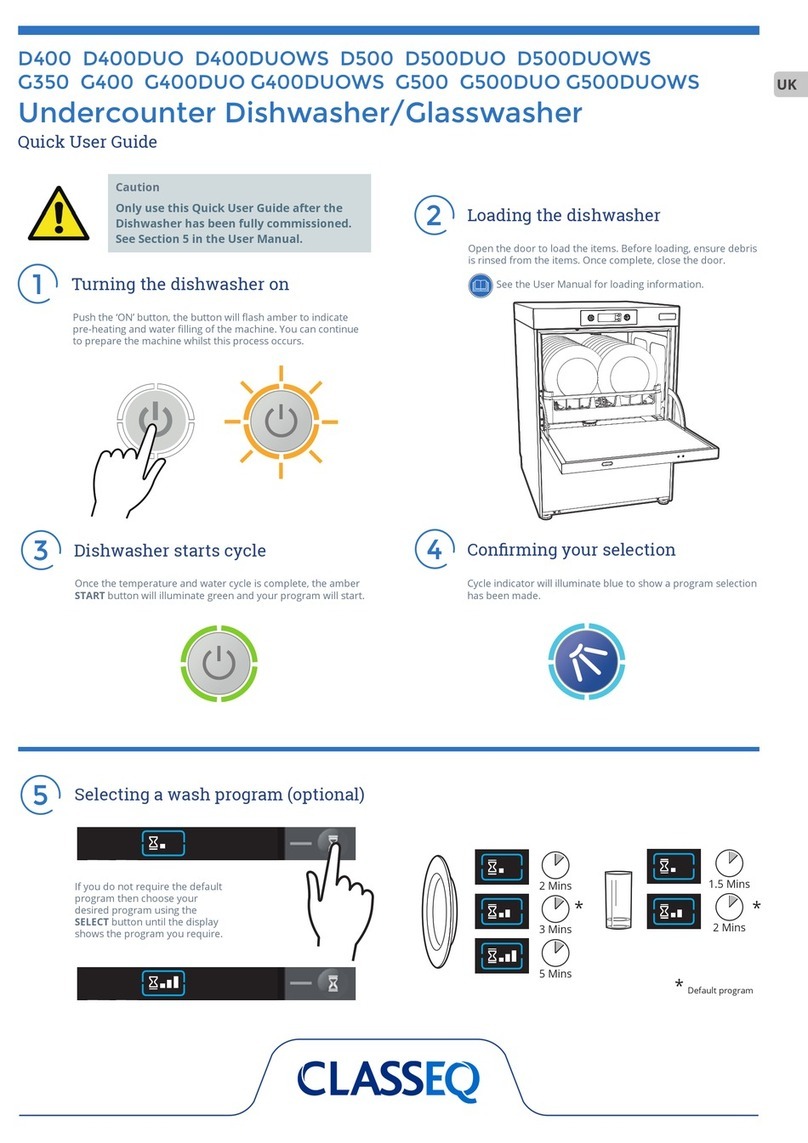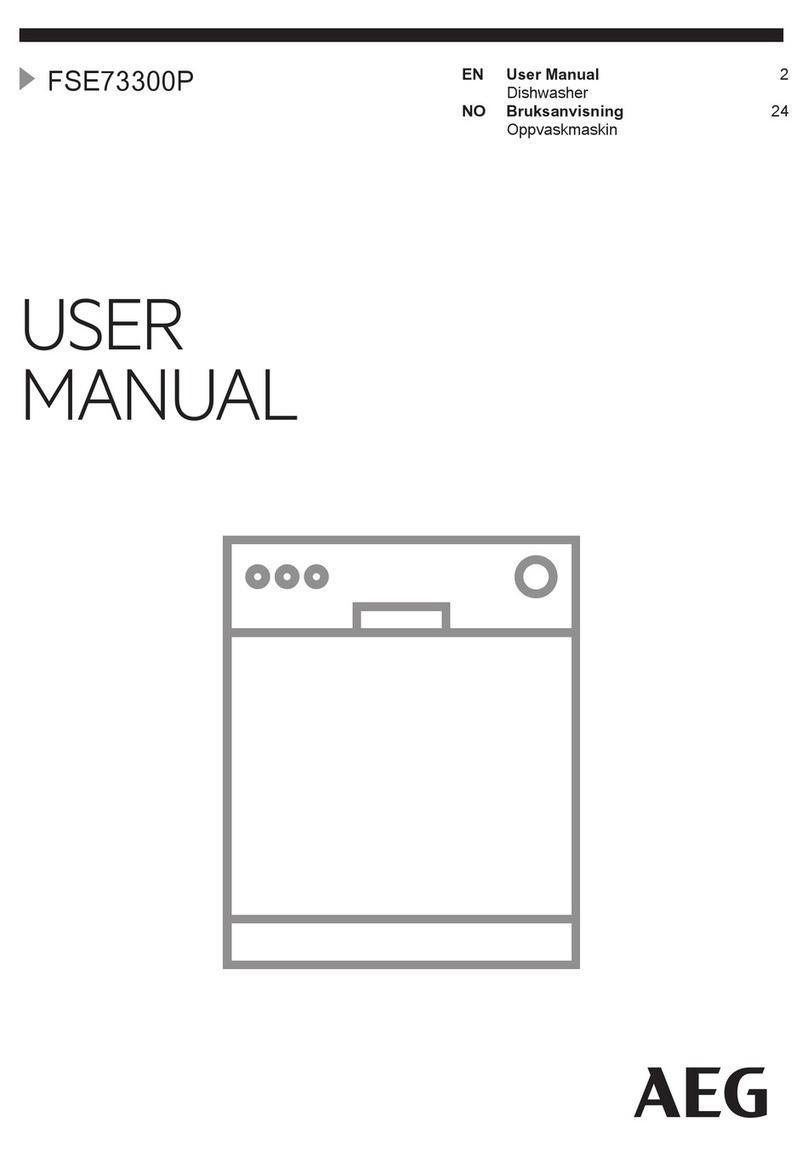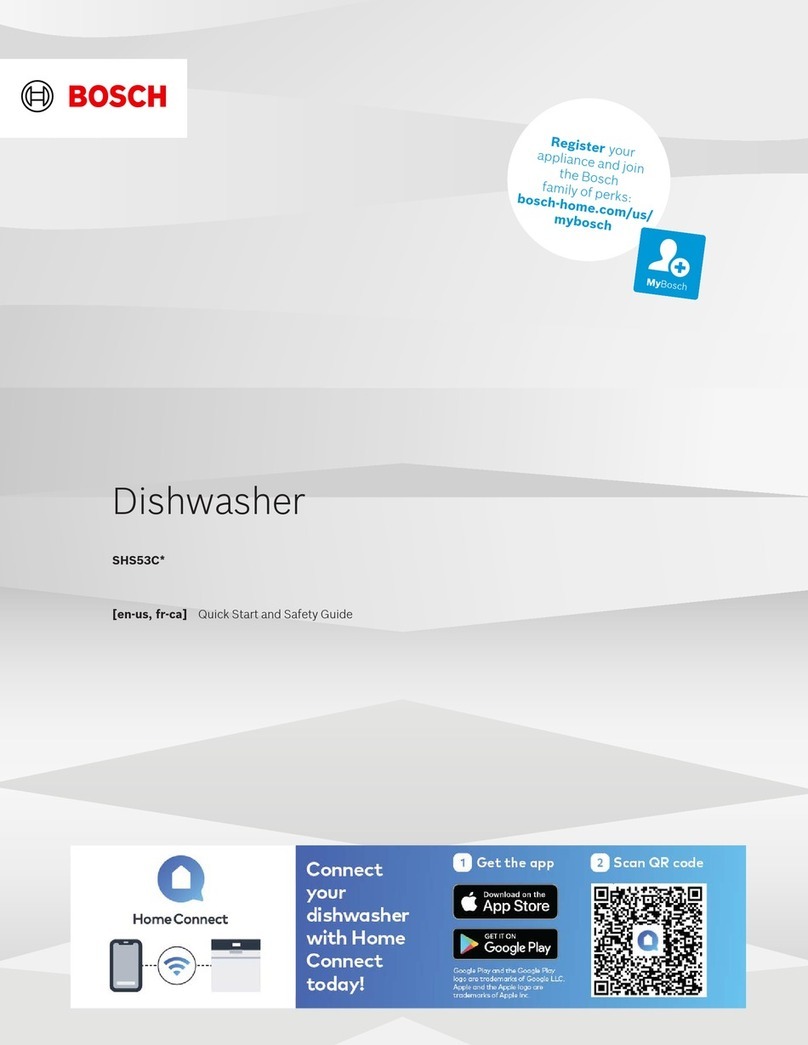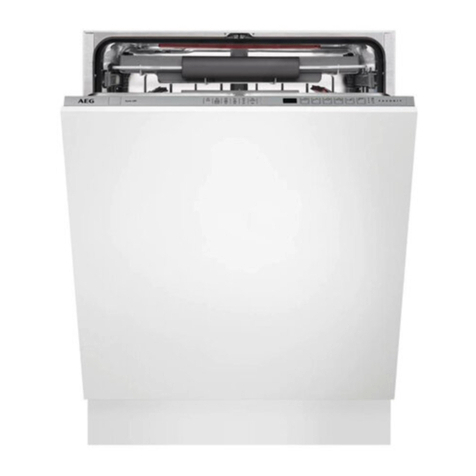M-system MVD-460 User manual

MVD-460
MVD-460 buildin dishwasher - 13

CONTENTS
Getting familiar with your machine ………………………………………………………. 4
•Technical specifications ……………………………………………………………… 5
•Conformity with the standards and Test data ………………………………………... 5
Safety information and Recommendations………………………................................ 5
•Recycling .......………………………................................................................................ 5
•Safety information ………………………………………………………………………. 5
•Recommendations …...…………………………………………………………………. 6
•Items not suitable for dishwashing ……………………………………………………. 7
Installing the machine ………………………………………………………………………. 7
•Positioning the machine ………………………………………………………………... 7
•Water connections …………………................................................................................ 7
•Water inlet hose ….……………………………………………………………………… 8
•Water outlet hose …..………………................................................................................ 8
•Electrical connection…………………………………………………………………….. 9
Preparing the machine for use ……………………………………………………………. 10
•The importance of water decalcification ……………………………………………… 10
•Filling with salt …………………………………………………………………………… 10
•Testing strip………………………………………………………………………………. 11
•Adjusting salt consumption……………………………………………………………... 11
•Detergent usage ……………………........................................................................ 13
•Filling the detergent compartment……………………………………………………... 13
•Combined detergent ……………………………………………………………………. 13
•Filling with rinse aid and making the setting………………………………………….. 14
1

Loading your dishwasher .…………………………………………………………………….. 16
•Dish rack …………………………………………………………………………………… 15
•Alternative basket loads …………………………………………………............................ 16
•Standard loading and Test data …………………………………………………………... 17
Programme descriptions .……………………………………………………………………... 18
•Programme items …………………………………………………………………………... 18
Switching on the machine and selecting a programme……………............................... 19
•Switching on the machine………………………………………………………………….. 19
•Programme follow-up……………………………………………………………………….. 19
•Changing a programme …………………………………………………………………… 19
•Changing a programme with resetting …………………………………………………… 20
•Switching the machine off ….……………………………………………………………… 20
Maintenance and Cleaning ............................................................................................... 21
•Filters ..………………………………………………………………………………………. 21
•Spray arms ………………………………………………………………………………….. 22
•Hose filter ……………………………………………………………………………………. 22
Failure codes and what to do in case of failure …………………………………………. 23
Practical and useful information……………………………………………………………... 25
2

1. Upper basket with racks 7. Control Panel
2. Upper spray arm 8. Detergent and rinse-aid dispenser
3. Lower basket 9. Cutlery basket
4. Lower spray arm 10. Salt dispenser
5. Filters 11. Upper basket track latch
6. Rating plate
3
12
$FWLYH Drying Unit: Thissystemprovides
better drying performance for your dishes.

1.) Power On/Off Button
When the Power On/Off button is pressed, the lamp on the
Start/Pause button starts lighting.
2.) Door Handle
The door handle is used to open/close the door of your
machine.
3.) Start/Pause Button
Once you press the Start/Pause button, the programme you
selected with the programme selector button will start running
and the status indicator lamp “wash/dry” will light up.
In the stop condition while wash/dry led is On, Start/Pause led will blink.
4.) Programme selector knob
With the programme selector knob, you can select a suitable programme
for your dishes.
5.) Wash-Dry / End-of-cycle indicator
You can monitor the programme status with the help of ‘wash/dry’ and
‘end’ indicators.
•Wash/Dry
•End
4
GETTING FAMILIAR WITH YOUR MACHINE

Technical specifications
Capacity …………………………
Height ………………….. ……….
Width ……………………………..
Depth …………………………….
Net Weight ……………………...
Electricity input ……………........
Total Power ……………………..
Heating Power …………………..
Pump Power …………………….
Drain Pump Power ……………..
Water supply pressure...............
Current …………………………..
12 place settings
8 mm - 870 mm
596 mm
570 mm
42 kg
220-240 V, 50 Hz
2200 W
2000 W
100 W
30 W
0.03 MPa (0,3 bar) - 1 MPa (10 bar)
10 A
•Producer company has its right to amend design and technical specifications reserved.
•The machine's service life is 10 years (the duration required to keep spare parts for the machine
to fulfil its usage functions).
Conformity with the standards and Test data / EC Declaration of Conformity
All stages related to the machine are executed in accordance with the safety rules provided in all
relevant directives of the European Community.
2004/108/EC, 2006/95/EC, IEC 436/DIN 44990, EN 50242
Recycling
•Certain components and the packaging of your machine have been produced from recyclable
materials.
•Plastic parts are marked with international abbreviations:
(>PE< , >PS< , >POM<, >PP<, ….)
•Cardboard parts have been produced from recycled paper and they should be disposed of into
waste paper collection containers for recycling.
•Such materials are not suitable for being disposed of into garbage bins. They should be delivered
to recycling centres instead.
•Contact relevant centres in order to obtain information on methods and points of disposal.
Safety Information
When you take delivery of your machine
•Check for any damage to your machine or to its packaging.
Never start a machine damaged in any way, make sure to contact an authorised service.
•Unwrap the packaging materials as indicated and dispose of them in accordance with the rules.
The points to pay attention during machine installation
•Choose a suitable, safe and level place to install your machine.
•Carry out the installation and connection of your machine by following the instructions.
•This machine should be installed and repaired by an authorised service only.
•Only original spare parts should be used with the machine.
SAFETY INFORMATION AND RECOMMENDATIONS
5
20

•Before installing, be sure that the machine is unplugged.
•Check whether the indoor electrical fuse system is connected according to the regulations.
•All electrical connections must match the values indicated on the rating plate.
•Pay special attention and be sure that the machine does not stand on the electricity supply cable.
•Never use an extension cord or a multiple socket for making a connection. The plug should be
comfortably accessible after the machine has been installed.
•After installing the machine to a suitable place, run it unloaded for the first time.
•Please assemble the dishwasher, which is inserted under or in the kitchen platform,
according to the instruction. Be sure that the product is fixed properly.
In daily use
•This machine is for household use, do not use it for any other purpose. Commercial usage of the
dishwasher will void the guarantee.
•Do not load your machine above its capacity; wash in the machine only those items which are
suitable for dishwashing.
•Do not get up, sit or place a load on the open door of the dishwasher, it may fall over.
•Never put into the detergent and rinse aid dispensers of your machine anything other than those
detergents and rinse aids which are produced specifically for dishwashers. Our company will not
be responsible for any damage that might occur in your machine otherwise.
•The water in the machine's washing section is no drinking water, do not drink it.
•Due to danger of explosion, do not put into the machine’s washing section any chemical
dissolving agents such as solvents.
•Check whether plastic items are heat-resistant before washing them in the machine.
•Do not put into your machine those items which are not suitable for dishwashing. Also, do not fill
any basket above its capacity. Our company will not be responsible for any scratch or rust to
form on the inner frame of your machine due to basket movements otherwise.
•Especially because hot water may flow out, the machine door should not be opened under any
circumstances while the machine is in operation. In any case, a safety devices ensures that the
machine stops if the door is opened.
•Do not leave your dishwasher’s door open. Failure to do so may lead to accidents.
•Place knives and other sharp-ended objects in the cutlery basket in blade-down position.
•This appliance is not intended for use by persons (including children) with reduced physical,
sensory or mental capabilities, or lack of experience and knowledge, unless they have been
given supervision or instruction concerning use of the appliance by a person responsible for their
safety.
For your children’s safety
•After removing the machine’s packaging, make sure that the packaging material is out of reach of
children.
•Do not allow children to play with or start the machine.
•Keep your children away from detergents and rinse aids.
•Keep children away from the machine while it is open because there may still be residues of
cleaning substances inside the machine.
•Be sure that your old machine does not pose any threat to your children. Children are known to
have gotten themselves locked in old machines. To forestall such a situation, break your
machine's door lock and tear off the electrical cables.
In case of malfunctioning
•Any malfunction in the machine should be repaired definitely by qualified persons. Any repair
work performed by anyone other than the authorised service personnel will cause your machine
to be left outside the scope of warranty.
6

•Prior to any repair work on the machine, be sure that the machine is cut off from the mains.
Switch off the fuse or unplug the machine. Do not pull by the cable when unplugging. Make sure
to turn off the water tap.
Recommendations
•For energy and water saving, remove coarse residues on your dishes before placing the dishes
into the machine. Start your machine after having fully loaded it
•Use the pre-wash programme only whenever necessary.
•Place such hollow items as bowls, glasses and pots into the machine in such a way that they will
face down.
•You are recommended not to load into your machine any dishes different or more than indicated.
Items not suitable for dishwashing:
•Cigarette ashes, candle leftovers, polish, chemical substances, iron-alloy materials;
•Forks, spoons and knives with wooden or bone, or ivory or nacre-coated handles; glued items,
paint, items soiled with abrasive, acidic or base chemicals
•Plastic items that are not heat-resistant, copper or tin-coated containers;
•Aluminium and silver objects (they may discolour, become dull)
•Certain delicate glass types, porcelains with ornamental printed patterns as they fade even after
the first wash; certain crystal items as they lose their transparency over time, adhered cutlery that
is not heat-resistant, lead crystal glasses, cutting boards, items manufactured with synthetic fibre;
•Absorbent items as sponges or kitchen rags are not suitable for dishwashing.
Warning: Take care to buy dishwasher-proof sets in your future purchases.
Positioning the machine
When determining the place to put your machine on, take care to choose a place where you can
easily load and unload your dishes.
Do not put your machine in any location where there is the probability for the room temperature to fall
below 0°C.
Before positioning, take the machine out of its packaging by following the warnings located on the
package.
Position the machine close to a water tap or drain. You need to site your machine, taking into
consideration that its connections will not be altered once they are made.
Do not grip the machine by its door or panel in order to move it.
Take care to leave a certain clearance from all sides of the machine so that you can comfortably move
it back and forth during cleaning.
Make sure that the water inlet and outlet hoses do not get squeezed while positioning the machine.
Also, make sure that the machine does not stand on the electrical cable.
Adjust the machine’s adjustable feet so that it can stand level and balanced. Proper positioning of the
machine ensures problem-free opening and closing of its door.
If the door of you machine does not close properly, check if the machine is stable on the floor it
stands; if not, adjust the adjustable feet and ensure its stable position.
INSTALLING THE MACHINE
7

Water connection
Be sure that the indoor plumbing is suitable for installing a dishwasher. Also, we recommend that you
fit a filter at the entrance of your place or apartment so as to avoid any damage to your machine
because of any contamination (sand, clay, rust etc.) that might be occasionally carried in through the
mains water supply or the indoor plumbing, and to forestall such complaints as yellowing and
formation of deposits after washing.
Water inlet hose
Do not use the water inlet hose of your old machine, if any. Use the new water
inlet hose supplied with your machine instead. If you are going to connect a
new or long-unused water inlet hose to your machine, run water through it for a
while before making the connection. Connect the water inlet hose directly to
the water inlet tap. The pressure supplied by the tap should be at a minimum
of 0.03 Mpa and and at a maximum of 1 Mpa. If the water pressure is above 1
Mpa, a pressure-relief valve should be fitted inbetween.
After the connections are made, the tap should be turned on fully and checked
for water tightness.
For the safety of your machine, make sure to always turn off the water inlet tap
after each wash programme is finished.
NOTE: Aquastop water spout is used in some models. In case of
using Aquastop, a dangerous tension exists. Do not cut Aquastop
water spout. Do not let it get folded or twisted.
Water outlet hose
The water drain hose can be connected either directly to the water drain
hole or to the sink outlet spigot. Using a special bent pipe (if available),
the water can be drained directly into the sink via hooking the bent pipe
over the edge of the sink.
This connection should be at a minimum of 50 cm and and at a maximum
of 110 cm from the floor plane.
Warning: When a drain hose longer than 4 m is used, the dishes might
remain dirty. In that case, our company will not accept responsibility.
8

Electrical connection
The earthed plug of your machine should be connected to an earthed outlet supplied by suitable
voltage and current. If there is no earthing installation, have a competent electrician carry out an
earthing installation. In case of usage without earthing installed, our company will not be responsible
for any loss of usage that might occur.
The indoor fuse current value should be 10-16 A.
Your machine is set according to 220-240 V. If the mains voltage in your location is 110 V, connect a
transformer of 110/220 V and 3000 W inbetween. The machine should not be plugged in during
positioning.
At low voltage, Wash efficiency of your machine decreases.
Always use the coated plug supplied with your machine.
The machine’s electrical cable should be replaced by an authorised service or an authorised
electrician only. Failure to do so may lead to accidents.
For safety purposes, always make sure to disconnect the plug when a wash programme is finished.
In order not to cause an electric shock, do not unplug when your hands are wet.
When disconnecting your machine from the mains supply, always pull from the plug. Never pull the
cord itself.
9

Prior to using the machine for the first time
•Check whether the electricity and supply water specifications match the values indicated by the
installation instructions for the machine.
•Remove all packaging materials inside the machine.
•Set the water softener.
•Add 2 kg salt into the salt compartment and fill with water up to a level at which it will almost
overflow.
•Fill the rinse aid compartment.
The importance of water decalcification
For a good washing function, the dishwasher needs soft, i.e. less calcareous water. Otherwise, white
lime residues will remain on the dishes and the interior equipment. This will negatively affect your
machine’s washing, drying and shining performance. When water flows through the softener system,
the ions forming the hardness are removed from the water and the water reaches the softness
required to obtain the best washing result. Depending on the level of hardness of the inflowing water,
these ions that harden the water accumulate rapidly inside the softener system. Therefore, the
softener system has to be refreshed so that it operates with the same performance also during the
next wash. For this purpose, dishwasher salt is used.
Filling with salt
Use softener salt specifically
produced for use in dishwashers.
To put softener salt, first remove the
lower basket and then open the salt
compartment cap by turning it
counter clockwise.12At first use fill
the compartment with 2 kg salt and
water 33 at overflowing level If
available,using the funnel 44
provided will make filling easier. refit
the cap ,and close it After every
20th-30th wash, add salt into your
machine until it fills up (approx. 1.5
kg) Fill the salt compartment with
water at first use only.We
recommend that you use
smallgrained or powder softener
salt.
Do not put table salt into your
machine.Otherwise, the function of
the softener compartment may
decrease over time. When you start
your dishwasher, the salt compartment gets filled with
water.Therefore, put the softener salt prior to starting your machine.
This way, overflowing salt gets immediately cleaned up through the wash operation. If you are not
going to wash any dishes immediately after putting salt, then run a short washing program with an
empty machine in order to avoid any damage ( to prevent corrosion ) to your machine due to the salt
overflow while filling in the salt container.
PREPARING THE MACHINE FOR USE
10

In order to understand whether or not the amount of softener salt in your machine is sufficient, check
the transparent section on the salt compartment cap. There is sufficient salt if the transparent section
is green. Salt has to be added if the transparent section is not green.
Testing strip
The washing effectiveness of your machine depends on the softness of the tap water. For this reason,
your machine is equipped with a system that reduces the hardness in mains water supply. The
washing effectiveness will increase when the system is correctly set. To find out the water hardness
level of water in your area, contact your local water board or determine water hardness level by using
the test strip(if available).
Adjusting salt consumption
Table of Water Hardness Level Settings
If the hardness of the water you use is above 90 dF (French hardness) or if you are using well
water; you are recommended to use filter and water refinement devices.
NOTE: Hardness level is adjusted to level 3 as a factory setting.
Open the
testing
strip.
Run
water
through
your tap
for 1
min.
Keep the
testing
strip in
water for 1
sec.
Shake the
testing strip
after taking it
out of water.
Wait for
1 min.
Make your machine’s water hardness
setting according to the result obtained
through the testing strip.
11

Adjusting salt consumption
Adjust the water softener according to how hard your tap water is.
Move the programme selector knob to the 0 (Reset) position while your machine is
not in operation.1
After resetting your machine, press the Start/Pause button and keep it pressed
down.2
Meanwhile, energise the machine by pressing the Power On/Off button. 4
Keep Start/Pause keys press until program monitor lights are on and off. 2
After the lamps “Wash/Dry-End” have flashed 3 ,release the Start/Pause
button. 2
Your machine displays the latest entered water hardness setting.
You can adjust the levels by pressing the Start/Pause button 2according to
Table of Water Hardness Level Settings.
After adjusting the water hardness level , press on/off button to save the settings
in memory. 4
12

Detergent usage
Use a detergent specifically designed for use in domestic dishwashers.
You can find powder,gel,and tablet detergents in the market that have been designed for
household dishwashers.
Detergent should be put into the compartment prior to starting the machine. Keep your
detergents in cool, dry places out of reach of your children.
Do not fill detergent into the detergent compartment more than required; otherwise it may cause
scratches on your glasses as well as lead to a poorly dissolved detergent.
Should you need more information concerning the detergent you will use, contact detergent
manufacturers directly.
Filling the detergent compartment
Push the latch to open the detergent container as shown in
the image. 1 Detergent pod has level lines inside. It is possible
to measure the right detergent amount using these lines.
Detergent pod can take totally 40 cm3detergent.
Open the dishwasher
detergent and pour
into the larger
compartment a25 cm3
if your dishes are
heavily soiled or 15
cm3if they are less soiled.2If your dishes have been
kept dirty for a very long time, if there are dried food
wastes on them, and if you have overly loaded the
dishwasher, pour a5cm3detergent into the pre-wash
compartment and start your machine.
You may have to add more detergent into your machine, depending on the degree of soil and
on the water hardness level in your area.
Combined detergents
Detergent manufacturers also manufacture combined detergents that are called 2 in 1 – 3 in
1- 5 in 1...
The 2 in1 detergents contain detergent+ salt or rinse aid . While using the 2 in 1 detergents,
it should be observed which functions the tablet consists of.
The other tablet detergents also have detergent+rinse aid +salt+various extra functions.
Generally, combined detergents produce sufficient results under certain usage conditions only.
Such detergents contain rinse aid and/or salt in preset amounts.
Points to consider when using this type of products:
•Always make sure to check the specifications of the product you will use or whether or not
it is a combined product.
•Check if the detergent used is appropriate for the hardness of mains water that machine is
appertaining to.
•Observe the instructions on packagings when using such products.
•If such detergents are in the form of tablets, never put them into the interior section or the
cutlery basket of the dishwasher. Always put the tablets into the detergent compartment in
the detergent dispenser.
13

•They produce good results for certain types of usage only. If you are using this type of
detergents, you need to contact the manufacturers and find out about the suitable
conditions of use.
•When the conditions of use of such products and the machine settings are appropriate,
they ensure savings in salt and/or rinse aid consumption.
•Contact the detergent manufacturers if you are not obtaining good wash results (if your
dishes stay calcareous and wet) after having used 2 in 1 or 3 in 1 detergents. The scope of
warranty for your machine does not cover any complaints caused by the use of these types
of detergents.
Recommended usage: If you want to obtain better results while using combined detergents,
add salt and rinse aid into your machine and adjust the water hardness setting and the rinse aid
setting to the lowest position.
Solubility of the tablet detergents produced by different companies can vary depending
on the temperature and time. Therefore, it is not recommended to use such detergents
in short programs. It is more suitable to use powder detergents in such programs.
Warning: Should any problem, which you have not encountered before, arise with the use of
this type of detergents, contact the detergent manufacturers directly.
When you give up using combined detergents
•Fill the salt and rinse aid compartments.
•Adjust the water hardness setting to the highest position and run an empty-wash.
•Adjust the water hardness level.
•Make the suitable rinse aid setting.
Filling with rinse aid and making the setting.
Rinse aid is used to prevent the stay of white water drops, lime stains, white film strip-
shaped stains that may form on the dishes, as well as to increase
the drying performance. Contrary to the popular beliefs, it is used
not only for obtaining shinier dishes but also for obtaining sufficiently
dried dishes. For this reason, care
should be taken that there is adequate
amount of rinse aid in the rinse aid
compartment and only polishing
material produced for use at
dishwashers should be used.
To put rinse aid, remove the rinse aid
compartment cap by turning it.1Fill the rinse aid compartment with
rinse aid until the rinse aid level indicator becomes dark;2refit the
cap and close it by turning it in a way
that the nails will correspond to one
another. By checking the rinse aid level indicator on the detergent
dispenser, you can understand whether or not your machine
needs rinse aid. A dark indicator b means that there is rinse aid in
the compartment, while a light indicator ashows that you need to
fill the compartment with rinse aid.
The rinse aid level adjuster can be set to a position between 1 and
6. Factory setting for rinse aid is the position 3.
You need to increase the degree of the adjuster if water stains
form on your dishes after a wash, whereas you need to decrease the degree if a blue
stain is left when wiped by hand.3
14

Warning: Use only those rinse aid materials which are allowed for use in the machine. As rinse
aid residues left as a result of overflowing will create extremely high amounts of foam and thus
reduce the washing performance, remove the excess amount of rinse aid by wiping it with a rag.
If you properly place your dishes into the machine, you will be using it in the best way in terms
of energy consumption, washing and drying performance.
There are two separate baskets for you to load your dishes into your machine. You can load into
the lower basket such round and deep items as pots with long handles, pot lids, plates, salad
plates, cutlery sets.
The upper basket has been designed for tea plates, dessert plates, salad bowls, cups and
glasses. When placing long-stem glasses and goblets, lean them against the basket edge, rack
or glass supporter wire and not against other items. Do not lean long glasses against one
another or they cannot remain steady and may receive damage.
It is more appropriate to locate the thin narrow parts into the middle sections of baskets.
You can place spoons among the other cutlery sets in order to prevent them from sticking to
one another. You are recommended to use the cutlery grid in order to obtain the best result.
To avoid any possible injuries, always place such long-handle and sharp-pointed dishes as
serving fork, bread knife etc. with their sharp points facing down or horizontally on the baskets.
Warning: Place your dishes into your machine in a way that they will not prevent the upper and
lower spray arms from spinning.
Dish rack
There are dish racks on the upper basket of
your machine. abYou can use these dish
racks in open or closed position. When they are
in open position ayou can place your cups on
them; and when in closed position byou can
place long glasses on the basket. Also, you can
use these racks by placing long forks, knives
and spoons on them laterally.
LOADING YOUR DISHWASHER
15
Bovenste serviesrek, hoogte-instelling
Het bovenste rek bevindt zich in de hoogste stand. In deze stand kunt u grote voorwerpen (pannen,
enz.) in het onderste rek plaatsen. Als het bovenste rek in de onderste stand staat, kunnen daarin
grote borden worden afgewassen.
Gebruik de wieltjes om de hoogte van het rek aan te passen. Open de beveiligingsdelen van het rek
aan het eind van de rails door de delen naar de zijkant open te draaien en haal het rek eruit. Verplaats
de wielen, duw het rek weer in de rails en sluit de beveiligingsdelen. Nu heeft u het bovenste rek in de
onderste stand geplaatst.

Alternative basket loads
Lower Basket
Top basket
Faulty loads
16

Standard loading and test data
Capacity:
Upper and lower baskets: 12 place settings. The upper basket should be adjusted to high position
Cups should be placed on the dish rack pins.
Detergent / Rinse aid
5+25 cm3, in accordance with EN50242-DIN 44990 IEC 436 (international norms) / Rinse aid dosage
adjustment: 4
Programme test
Eco 50°C, in accordance with EN 50242 (international norms)
17

18
Programmeitems
Warning:Short programs do not include a drying step
The values declared above are the values obtained under laboratory conditions according to
relevant standards. These values can change depending on conditions of product’s use and
environment (network tension, water pressure, water input temperature and environment
temperature).
Programme No Reference
Programme
names and
temperatures
40° C
50°C
Eco Super 50 min.
65°C
Intensive
65°C
Type of food
waste
coee, milk, tea,
cold meats,
vegetables, not
kept for long
coee, milk, tea,
cold meats,
vegetables, not
kept for long
soups, sauces,
pasta, eggs,
pilaf, potato and
oven dishes,
fried foods
Level of soil
small medium
medium
Detergent
amount
A: 25 cm 3/
15 cm 3
B: 5 cm 3
A A+B A+B
Programme
30 155 50
(kW hours)
0,90 0,95 1,35
Water
12,4 12,4 12,7
110
1,55
17,2
Prewash
50°C wash
Cold rinse
Hot rinse
Dry
End
40°C wash
Cold rinse
Hot rinse
End
65 °C wash
Cold rinse
Hot rinse
End
soups, sauces,
pasta, eggs,
pilaf, potato and
oven dishes,
fried foods
high
A+B
Pre wash
65 °C wash
Cold rinse
Hot rinse
Dry
End
PROGRAMME
DESCRIPTIONS
** Super 50 min. with this programme, you can wash your dishes in A washing performance.

1. Press the Power On/Off key.
2. Select the program suiting your
dishes via the Program Selection
button.
3. Start the program pressing
the Power Start/Pause key.
Switching on the machine
Program follow-up
You can follow the program flow using the program follow-up lambs located on the control panel.
Changing a programme
If you would like to change programs while a washing program is continuing.
SWITCHING ON THE MACHINE AND
SELECTING A PROGRAMME
19
Once the Power On/Off key
is pressed, the lamp Power
Start/Pause is highlighted.
Press once the Power
Start/Pause key.
Start the program you have
newly selected by pressing
again the Start/Pause key.
The new program started
will resume the course of
the old program.
Once the program is over, the
lamp Finished is illuminated.
Do not open the cover before
the lamp Finished is on.
As long as Washing and Drying goes
on the Washing/Drying lamp goes on
to light .When drying is active machine
stays silent about 40-50 minutes.
The lamp on Program Start/Pause key
goes off once the Program starts and
the washing/drying lamp is highlighted.
After the program stops, select
your desired program via the
Program selection button.
Table of contents
Other M-system Dishwasher manuals
